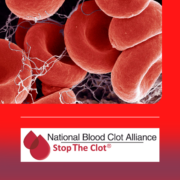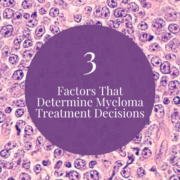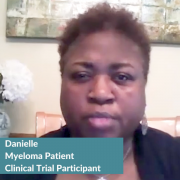Key Considerations When Choosing Myeloma Treatment: What’s Available?
Key Considerations When Choosing Myeloma Treatment: What’s Available? from Patient Empowerment Network on Vimeo.
Beth Faiman, a nurse practitioner specializing in multiple myeloma at the Cleveland Clinic, shares tips for making treatment decisions and discusses the evolution of myeloma therapy in recent years. Need help speaking up? Download the Office Visit Planner and bring it to your next appointment here.
Beth Faiman is a nurse practitioner in the department of hematologic oncology at Cleveland Clinic. More about this expert here.
See More From The Pro-Active Myeloma Patient Toolkit
Subscribe to stay up-to-date in the latest information in Multiple Myeloma treatment
Related Resources

|
Transcript:
Beth Faiman:
There are so many treatment options, and that’s one of the reasons why it’s so important for patients to at least seek an opinion once or twice with a myeloma specialist because treatment changes so rapidly. We have over 20 medications that are approved for the management of myeloma and so the patients need to figure out what’s important for them.
Oftentimes you think, father knows best or doctor knows best. And I hear from time to time that you’re the doctor, you should know what is best for me. But I say, “I understand what might be the best treatment for you in terms of response rate, but we have to balance quality and quantity of life. What are the things that you’re willing and your family’s willing to accept for treatment?”
Do you want to undergo a stem cell transplant which maybe takes you out of commission for a couple of months? Or take an oral therapy every day or an IV therapy intermittently? So, there are oftentimes more than one decision, and this is what we like to practice at my institution. It’s called shared decision making where you have a partnership between the patient and their caregiver, and the healthcare team and we work together to mutually decide what’s best for that patient.
So, sometimes just really trying to get that cure or eliminate the myeloma cell clone as best as possible might not be the right answer now, especially if you’re a single mom or a single dad or caring for a loved one. But maybe that might be a future goal. So, having that conversation is so important. And patients should feel empowered to be able to have that conversation with their healthcare team because if they don’t, then maybe they need to see a different doctor or specialist so they can feel comfortable with them.
I am so excited about all the new classes of drugs that are so — that are currently available. When I started managing myeloma in 1994 or 1995 there was only stem cell transplant and maybe melphalan or Cytoxan, and those drugs were not very effective in controlling the disease. I’m now able to mix and match treatments and give patients different opportunities to meet these milestones. You know, patients were so worried about not being here in two or three years, and now it’s 20 years later. So, forming those relationships and keeping them living healthy longer is so important.
We now have drugs available that can have the possibility of achieving what’s called minimal residual disease or MRD, where we’re eliminating in the bone marrow, the myeloma clone
That was unheard of five years ago even. So now we have the BiTE therapies and CAR T-Cell therapies, and some of the newer drug classes that will hopefully have a functional cure.
People ask me what a cure in myeloma is, and hopefully, we’ll have a real cure. But, living out your normal life span compared to people that don’t have myeloma, and really enjoying life as you do it. So, I always tell patients don’t forget about health maintenance and checking cholesterols, looking for secondary cancers, keep a primary care provider on hand because as a team, we can all work together, to have you live your best life as possible.












